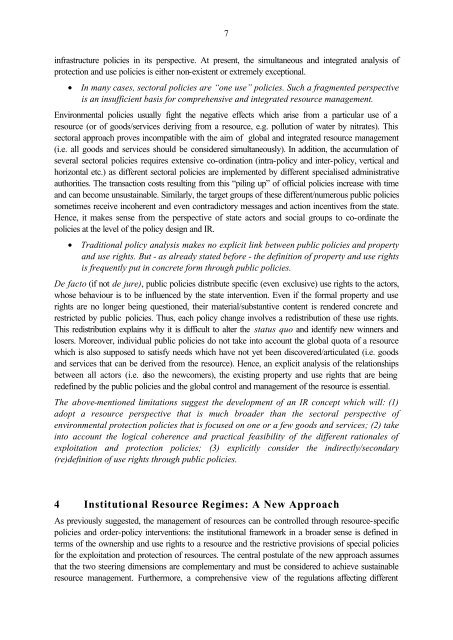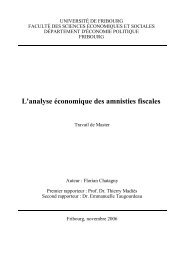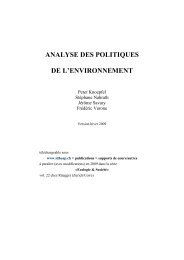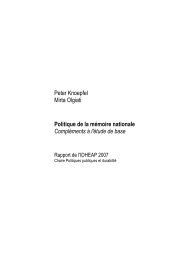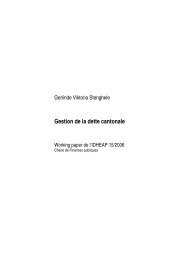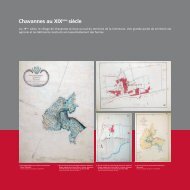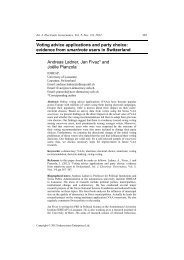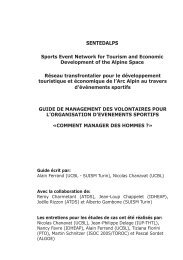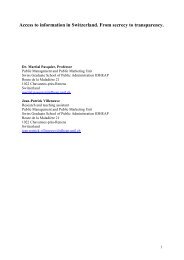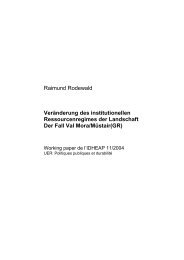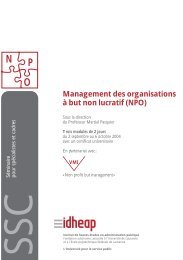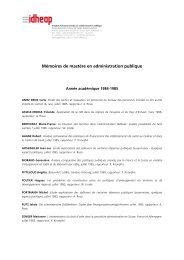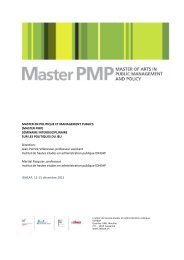Historical Analysis of Institutional Regimes in Switzerland ... - IDHEAP
Historical Analysis of Institutional Regimes in Switzerland ... - IDHEAP
Historical Analysis of Institutional Regimes in Switzerland ... - IDHEAP
Create successful ePaper yourself
Turn your PDF publications into a flip-book with our unique Google optimized e-Paper software.
7<br />
<strong>in</strong>frastructure policies <strong>in</strong> its perspective. At present, the simultaneous and <strong>in</strong>tegrated analysis <strong>of</strong><br />
protection and use policies is either non-existent or extremely exceptional.<br />
• In many cases, sectoral policies are “one use” policies. Such a fragmented perspective<br />
is an <strong>in</strong>sufficient basis for comprehensive and <strong>in</strong>tegrated resource management.<br />
Environmental policies usually fight the negative effects which arise from a particular use <strong>of</strong> a<br />
resource (or <strong>of</strong> goods/services deriv<strong>in</strong>g from a resource, e.g. pollution <strong>of</strong> water by nitrates). This<br />
sectoral approach proves <strong>in</strong>compatible with the aim <strong>of</strong> global and <strong>in</strong>tegrated resource management<br />
(i.e. all goods and services should be considered simultaneously). In addition, the accumulation <strong>of</strong><br />
several sectoral policies requires extensive co-ord<strong>in</strong>ation (<strong>in</strong>tra-policy and <strong>in</strong>ter-policy, vertical and<br />
horizontal etc.) as different sectoral policies are implemented by different specialised adm<strong>in</strong>istrative<br />
authorities. The transaction costs result<strong>in</strong>g from this “pil<strong>in</strong>g up” <strong>of</strong> <strong>of</strong>ficial policies <strong>in</strong>crease with time<br />
and can become unsusta<strong>in</strong>able. Similarly, the target groups <strong>of</strong> these different/numerous public policies<br />
sometimes receive <strong>in</strong>coherent and even contradictory messages and action <strong>in</strong>centives from the state.<br />
Hence, it makes sense from the perspective <strong>of</strong> state actors and social groups to co-ord<strong>in</strong>ate the<br />
policies at the level <strong>of</strong> the policy design and IR.<br />
• Traditional policy analysis makes no explicit l<strong>in</strong>k between public policies and property<br />
and use rights. But - as already stated before - the def<strong>in</strong>ition <strong>of</strong> property and use rights<br />
is frequently put <strong>in</strong> concrete form through public policies.<br />
De facto (if not de jure), public policies distribute specific (even exclusive) use rights to the actors,<br />
whose behaviour is to be <strong>in</strong>fluenced by the state <strong>in</strong>tervention. Even if the formal property and use<br />
rights are no longer be<strong>in</strong>g questioned, their material/substantive content is rendered concrete and<br />
restricted by public policies. Thus, each policy change <strong>in</strong>volves a redistribution <strong>of</strong> these use rights.<br />
This redistribution expla<strong>in</strong>s why it is difficult to alter the status quo and identify new w<strong>in</strong>ners and<br />
losers. Moreover, <strong>in</strong>dividual public policies do not take <strong>in</strong>to account the global quota <strong>of</strong> a resource<br />
which is also supposed to satisfy needs which have not yet been discovered/articulated (i.e. goods<br />
and services that can be derived from the resource). Hence, an explicit analysis <strong>of</strong> the relationships<br />
between all actors (i.e. also the newcomers), the exist<strong>in</strong>g property and use rights that are be<strong>in</strong>g<br />
redef<strong>in</strong>ed by the public policies and the global control and management <strong>of</strong> the resource is essential.<br />
The above-mentioned limitations suggest the development <strong>of</strong> an IR concept which will: (1)<br />
adopt a resource perspective that is much broader than the sectoral perspective <strong>of</strong><br />
environmental protection policies that is focused on one or a few goods and services; (2) take<br />
<strong>in</strong>to account the logical coherence and practical feasibility <strong>of</strong> the different rationales <strong>of</strong><br />
exploitation and protection policies; (3) explicitly consider the <strong>in</strong>directly/secondary<br />
(re)def<strong>in</strong>ition <strong>of</strong> use rights through public policies.<br />
4 <strong>Institutional</strong> Resource <strong>Regimes</strong>: A New Approach<br />
As previously suggested, the management <strong>of</strong> resources can be controlled through resource-specific<br />
policies and order-policy <strong>in</strong>terventions: the <strong>in</strong>stitutional framework <strong>in</strong> a broader sense is def<strong>in</strong>ed <strong>in</strong><br />
terms <strong>of</strong> the ownership and use rights to a resource and the restrictive provisions <strong>of</strong> special policies<br />
for the exploitation and protection <strong>of</strong> resources. The central postulate <strong>of</strong> the new approach assumes<br />
that the two steer<strong>in</strong>g dimensions are complementary and must be considered to achieve susta<strong>in</strong>able<br />
resource management. Furthermore, a comprehensive view <strong>of</strong> the regulations affect<strong>in</strong>g different


